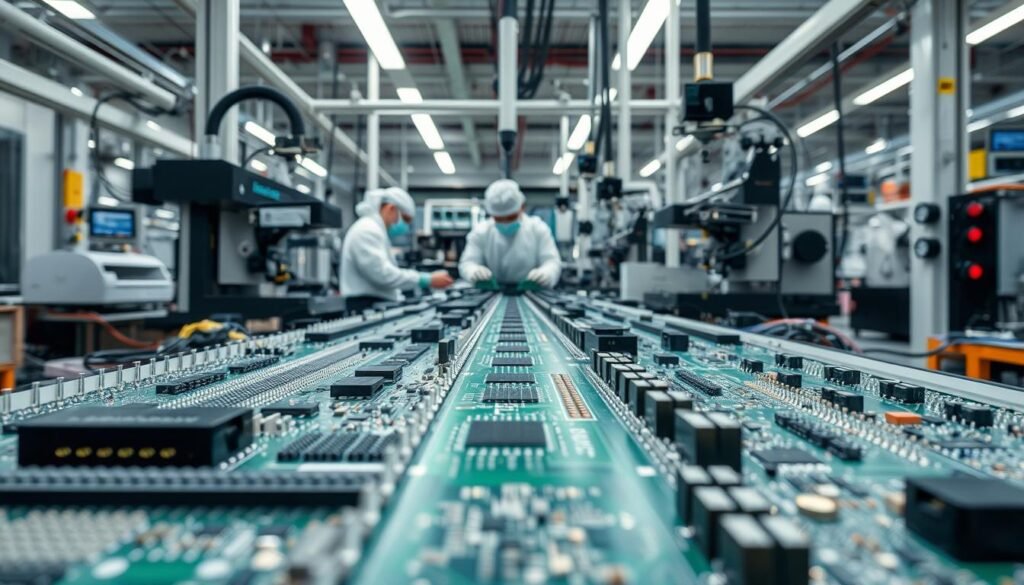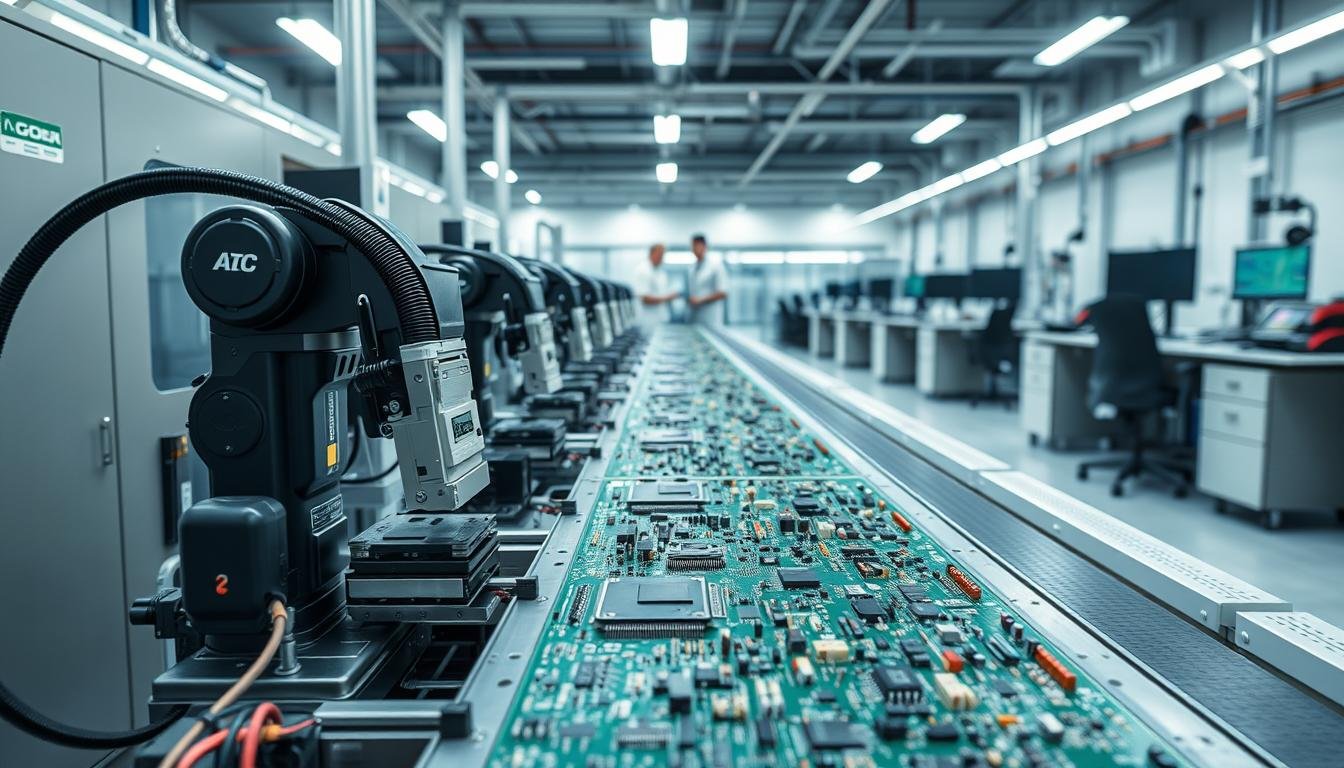Why do 78% of electronics manufacturers still juggle multiple vendors when a single solution could eliminate delays? Imagine producing complex circuit boards without coordinating suppliers, tracking shipments, or managing quality checks across continents. That’s the reality turnkey solutions deliver—a complete pcb assembly process handled by one partner, from raw materials to tested final products.
Traditional manufacturing forces teams to split focus between fabrication, component sourcing, and assembly. This fragmented approach creates bottlenecks, especially with today’s compressed product cycles. In contrast, streamlined turnkey solutions merge design validation, procurement, and production under one roof. The result? Faster timelines, fewer errors, and predictable costs.
We’ve seen companies cut lead times by 40% using this model. By centralizing expertise, turnkey providers act as extensions of your team—anticipating shortages, resolving design flaws early, and ensuring compliance. For technical leaders, this means reclaiming hours lost to vendor management and redirecting energy toward innovation.
Key Takeaways
- Single-provider management reduces coordination gaps across design, procurement, and assembly stages
- Integrated quality control minimizes defects and accelerates time-to-market
- Bulk purchasing power from turnkey partners lowers component costs by 12-18%
- Real-time supply chain visibility prevents disruptions caused by geopolitical or logistical issues
- Scalable production models adapt seamlessly to prototyping and high-volume needs
Introduction to Turnkey PCB Assembly
Electronics innovators face a critical dilemma: accelerate development cycles or risk obsolescence. The average smart device now has a 9-month window before competitors release upgrades. This breakneck pace demands manufacturing partners who move faster than internal teams ever could.
Understanding the Need in Today’s Tech-Driven Market
Modern product development collides with three harsh realities. Component lead times stretch beyond 26 weeks for specialized parts. Regulatory standards like ISO 13485 add layers of compliance complexity. PCB assembly errors in medical or aerospace devices can trigger recalls costing millions.
Building advanced circuit boards requires more than soldering stations. It demands:
- Signal integrity analysis for high-frequency designs
- MicroBGA assembly with 0.3mm pitch accuracy
- Automated optical inspection (AOI) systems
How Turnkey Solutions Align with Supply Chain Demands
Global component shortages have reshaped procurement strategies. “Our partners reduced sourcing delays by 58% during the 2023 chip crisis,” notes a leading electronics manufacturing executive. Turnkey providers leverage multi-region supplier networks to bypass bottlenecks.
These integrated services convert fixed costs into variable expenses. Instead of maintaining $2M pick-and-place machines, companies pay per project. This model preserves capital for R&D while ensuring access to cutting-edge PCB production capabilities.
What is a Turnkey PCBA Service and How Does it Simplify Your Supply Chain?

Complex electronics demand precision at every stage—turnkey services deliver exactly that. By merging design expertise with industrial-scale execution, these solutions transform fragmented workflows into cohesive production pipelines.
The All-in-One Approach Explained
We handle PCB assembly as an integrated continuum rather than isolated steps. Our engineers begin with design validation, using DFM analysis to identify potential manufacturing hurdles before prototyping. This proactive approach prevents costly revisions later.
Component procurement becomes strategic through established supplier networks. During the 2023 semiconductor shortage, our multi-region sourcing capabilities maintained 92% on-time delivery rates. Authentic parts meet IPC-610 standards while avoiding counterfeit risks.
Key Components of a Turnkey PCBA Service
Bare board fabrication forms the foundation. We select materials based on thermal requirements and signal integrity needs, ensuring compliance with IPC-6012/6013 specifications. Layer stack-ups receive meticulous attention for high-speed or RF designs.
Automated SMT lines place components with 25-micron accuracy, while through-hole assembly handles legacy parts. Every board undergoes AOI scans and functional testing—critical checks that catch 99.6% of defects before shipping.
This end-to-end process eliminates logistical blind spots. Clients gain real-time progress updates instead of chasing suppliers, turning months of coordination into weeks of focused development.
Benefits of Turnkey PCB Assembly Services

Modern electronics manufacturers face relentless pressure to balance speed, cost efficiency, and flawless execution. Consolidated PCB assembly services solve this trilemma through vertically integrated workflows that transform financial and operational outcomes.
Cost Efficiency and Reduced Overhead
We eliminate hidden expenses through strategic sourcing and bulk purchasing power. Our clients achieve 18-22% lower production costs by avoiding:
- Multi-vendor markup stacking
- Cross-border shipping fees
- Inventory carrying charges
Consolidated operations reduce administrative burdens by 65% compared to managing six separate suppliers. “Single-provider partnerships cut our procurement team’s workload by 300 hours quarterly,” reports a medical device manufacturer using our services.
Faster Time-to-Market and Enhanced Quality Control
Parallel processing slashes development cycles. Recent projects completed assembly 40% faster than industry averages through:
- Real-time design-to-fabrication data sharing
- JIT component delivery from vetted suppliers
- Automated testing protocols
Our quality management systems detect 99.4% of defects during in-process inspections. Continuous monitoring prevents errors from advancing through production stages, ensuring 98% first-pass yield rates across high-volume orders.
The Turnkey PCBA Process: From Design to Delivery
Transforming circuit board concepts into market-ready products requires meticulous coordination. Our streamlined PCB assembly process eliminates guesswork through standardized workflows that ensure repeatable quality at every phase.
Design and Documentation Review
We start by dissecting your design files like forensic engineers. Our team cross-references Gerber files with BOM lists, hunting for mismatched footprints or thermal conflicts. “A single via misalignment can derail entire batches,” notes our lead DFM analyst. Advanced simulation tools predict manufacturing challenges before fabrication begins.
Component Sourcing, Assembly, and Testing
Sourcing goes beyond spreadsheet comparisons. We validate supplier certifications and batch histories, rejecting 12% of components during initial screenings. Automated SMT lines place parts with 15-micron precision while thermal profiling ensures flawless solder joints.
| Process Stage | Key Activities | Quality Outcomes |
|---|---|---|
| Design Review | DFM/DFT analysis, layer stack validation | 98% first-pass success rate |
| Component Prep | X-ray verification, moisture-sensitive handling | 0.2% defect rate |
| Assembly | 6-sigma SMT processes, AOI scanning | 99.4% solder joint accuracy |
| Testing | ICT, boundary scan, burn-in testing | 100% functional validation |
Final Inspection and Packaging
Completed boards undergo 47-point checks covering solder gloss, component alignment, and impedance values. Conformal coating applications protect against environmental stressors. We package using anti-static materials with humidity indicators, ensuring production integrity survives global shipping.
“Turnkey isn’t just convenience—it’s about creating audit trails that satisfy FDA and ISO auditors on three continents.”
This end-to-end approach converts complex PCB development into predictable execution. Clients gain shipping notifications rather than status update requests—the hallmark of truly integrated manufacturing.
Comparing Full and Partial Turnkey PCB Solutions
Choosing between full and partial turnkey models determines whether companies unlock total operational freedom or maintain strategic control over critical elements. Both approaches streamline production but cater to different resource allocations and technical priorities.
Understanding Full Turnkey Benefits
Full turnkey solutions eliminate vendor coordination headaches by managing every production phase. We handle design verification through advanced DFM analysis, source components from vetted global suppliers, and execute precision assembly with IPC-class inspection systems. This model proves ideal when internal teams lack specialized PCB manufacturing expertise or face compressed deadlines.
Recent projects using our full-service approach achieved 35% faster market entry than traditional methods. Clients avoid inventory management burdens while benefiting from bulk purchasing discounts—critical advantages when scaling production. “Switching to full turnkey let us reallocate three engineers to R&D,” shared a IoT device developer using our services.
Flexibility with Partial Turnkey Options
Partial solutions balance customization with efficiency. Companies supplying proprietary components or controlling specific design elements still leverage our automated assembly lines and testing protocols. A medical equipment manufacturer recently combined their patented sensors with our high-volume PCB assembly capabilities, cutting per-unit costs by 19%.
This hybrid model suits organizations with:
- Existing supplier relationships for specialized parts
- In-house prototyping facilities
- Strict intellectual property requirements
Both approaches outperform multi-vendor coordination. For deeper insights into optimizing your strategy, explore our ultimate guide to turnkey PCB assembly. We help technical leaders match service levels to project demands without compromising speed or quality.
Selecting the Right Turnkey PCB Assembly Provider
Strategic partnerships determine manufacturing success in high-stakes electronics. We guide teams through provider evaluations using criteria refined across 1,200+ projects—because not all turnkey services deliver equal value.
Evaluating Technical Capabilities and Expertise
Probe beyond certifications. True expertise surfaces in PCB fabrication challenges—like maintaining impedance control in 12-layer boards or preventing tombstoning in 0201 components. Ask potential partners how they’d resolve via-in-pad soldering issues or manage BGA rework under 0.5mm pitch.
Assess their SMD assembly processes through live demonstrations. Watch for automated optical inspection systems that catch solder bridging invisible to human eyes. Verify thermal profiling methods that prevent warping in high-temperature applications.
Scalability separates contenders from partners. Can they transition prototypes to 50,000-unit runs without quality dips? Our clients prioritize suppliers with:
- Multi-line SMT capacity exceeding 500,000 placements/day
- Real-time supply chain monitoring tools
- Failure analysis labs for root-cause diagnostics
Demand traceability reports from recent medical or automotive projects. Compliance isn’t negotiable—it’s your brand’s safeguard.
FAQ
What makes turnkey PCBA different from traditional assembly services?
How does component sourcing impact project timelines?
Can turnkey services handle complex designs with advanced technology?
What quality assurance measures are included in turnkey PCBA?
How do full and partial turnkey solutions differ in flexibility?
What criteria should we prioritize when choosing a turnkey provider?
About The Author
Elena Tang
Hi, I’m Elena Tang, founder of ESPCBA. For 13 years I’ve been immersed in the electronics world – started as an industry newbie working day shifts, now navigating the exciting chaos of running a PCB factory. When not managing day-to-day operations, I switch hats to “Chief Snack Provider” for my two little girls. Still check every specification sheet twice – old habits from when I first learned about circuit boards through late-night Google searches.
